Every email you send adds an impression of your professionalism, attention to detail, and ability to communicate effectively with others. How you end your emails is just as important as how you begin them, making the closing words a key factor in effective email marketing and communication.
Two phrases stand out when deciding how to end your emails: “Best regards” and “Kind regards.” What's the difference between these two expressions? How should they be used appropriately?
This guide will delve into all the details behind “Best regards” and “Kind regards” so that you can confidently use either without worrying about cultural nuances or etiquette rules.
What is the difference between “Best regards” and “Kind regards”?
The primary difference between “Best regards” and “Kind regards” is the level of formality; “Best regards” is a slightly more formal greeting than “Kind regards.”
However, both are considered polite and appropriate for business emails, with “Best regards” being best suited to formal emails such as sales emails or job applications.
In contrast, “Kind regards” can be used in more casual situations, such as when emailing colleagues or clients with whom you have an existing relationship.
For example, suppose you email a hiring manager for a job application. In this case, it would be appropriate to use “Best regards” as your closing to reflect the formality of the situation.
On the other hand, if you are writing an email to thank a colleague for their help with a project, “Kind regards” is more suitable as it reflects the less formal nature of the message.
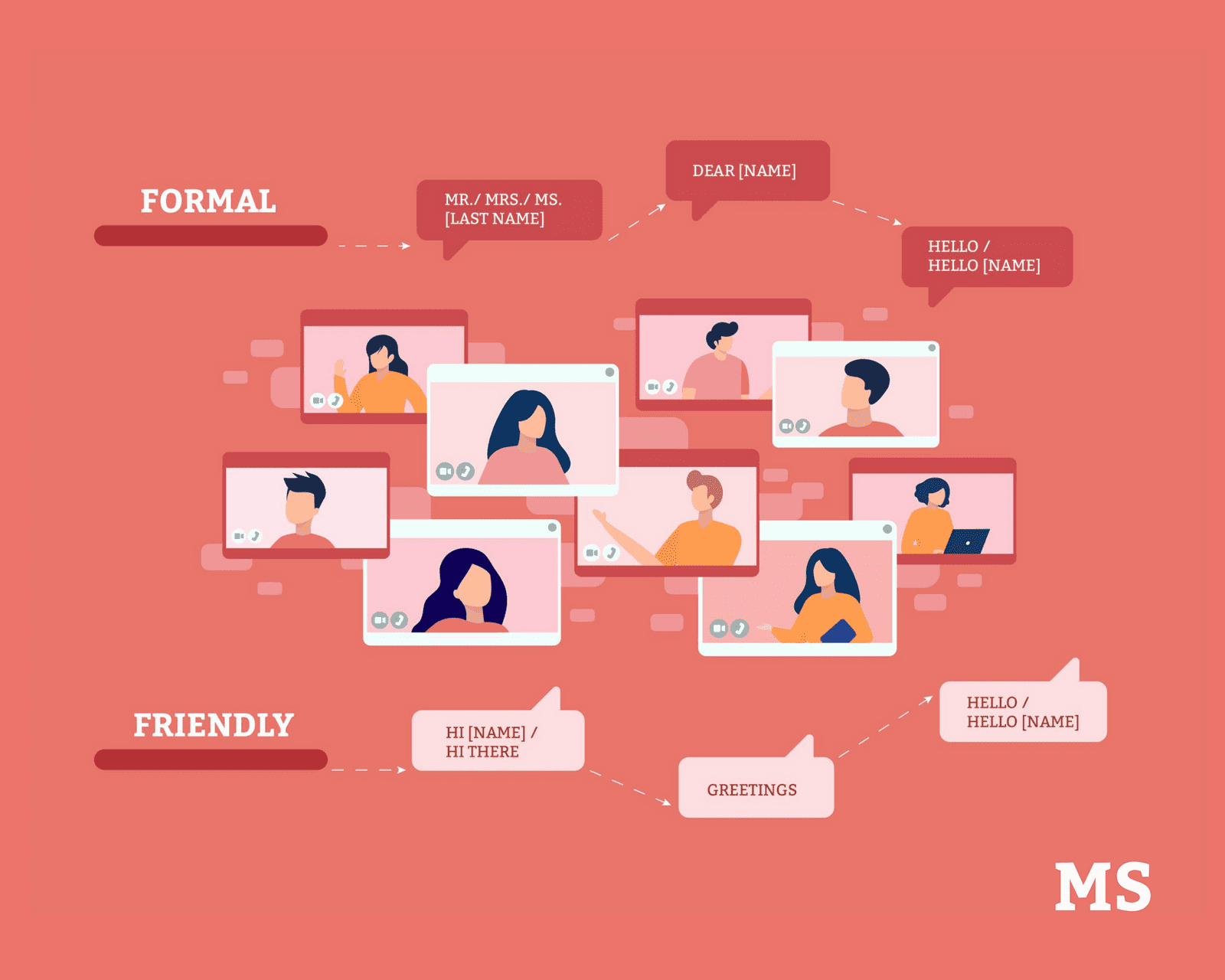
(Source: MarketSplash)
The importance of having a good email ending
A good ending for your email isn’t just a nice touch; it also serves a vital role in creating a lasting impression on the recipient.
Whether you are writing to a colleague or a potential client, having an appropriate email closing can make all the difference between success and failure. Discover some reasons to include a proper email ending.
-
You don't want to sound rude
An appropriate email ending can help ensure you don't come across as rude or abrupt. For example, if you are writing to a potential customer, using “Best regards” rather than “Kind regards” sends the message that you value their business and appreciate their time.
Similarly, if you are addressing someone senior in your company, opt for a more formal closing such as “Respectfully” or “Yours sincerely.” Otherwise, your intention may come across differently and be seen as disrespectful.
-
You want to leave a good impression
An appropriate email ending is essential if you want to leave a good impression on the recipient. For example, if you are sending a cover letter for a job application, it is essential that your email closing projects professionalism and respect for the employer.
In this situation, using “Best regards” would be more appropriate than “Kind regards” as it shows that you take the position seriously.
Some alternative closings that can help create a professional impression include:
- “Respectfully”;
- “Yours faithfully”;
- “With appreciation.”
The goal is to make the recipient feel respected and valued, no matter who they are.
-
Increase chances of getting a reply
If you want to reduce the rate of unread emails and increase your chances of getting a reply, then having an appropriate email ending can help to achieve this.
For example, if you are writing to a colleague, then using “Kind regards” shows that you value their time and would appreciate a response.
In the same way, when you are addressing someone for the first time, opt for a friendlier closing, such as “Best wishes,” as this can help create a more positive rapport between you and the recipient.
The recipient will also feel that you understand their situation and appreciate the fact that they may not be able to respond immediately.
-
Show appreciation with your email closing
No matter what email you send, focus on how to end your emails to show appreciation for the recipient's time and effort. For example, if you are writing to a customer, using “Thank you” can help express your gratitude for their business.
Similarly, using “Kind regards” when addressing someone who has taken the time to read your email can show them that you appreciate their input and value their opinion.
This type of closing is essential when sending emails to those who have helped you in some way or provided helpful advice.
-
Leave room for further discussion
Your email ending should also be chosen carefully, as it can help leave the door open for further discussion. For example, if you are writing to a colleague, using “Cheers” or “Best wishes” can create a relaxed atmosphere that may encourage them to respond more quickly.
In the same way, when sending a job application cover letter, you must use an appropriate closing such as “Respectfully” or “Yours faithfully,” as this shows that you are serious about the position and are keen to discuss it further.
“Best regards” vs. “Kind regards”
To decide the most suitable closing for an email, learn more about the differences between “Best regards” vs. “Kind regards” and when each is appropriate.
Why is it important to know the difference?
Using the wrong closing for a message can create an awkward or even offensive situation. For example, using “Best regards” in an informal email could make it appear overly formal, making it seem like you don't value the recipient's opinion. Similarly, using “Kind regards” in a job application could be seen as too informal and unprofessional, giving off a negative impression of your character.
Additionally, knowing the difference between these two closings allows you to tailor the tone of each message according to its purpose.
For example, if writing a cold email, using “Best regards” will create a more businesslike atmosphere, whereas using “Kind regards” will show that you value the relationship between yourself and the recipient.
When to use “Best regards”
As a general rule, using “Best regards” is best when writing a formal email or when you need to make a good impression on the recipient, such as in sales emails, job applications, and business proposals.
However, it can also be used in letters of resignation, thank-you notes, invitations, and other professional correspondence.
For example, when writing a cold email to a potential client, “Best regards” would be an appropriate closing as it reflects the formality of the situation. In the same way, if you wish to resign from your job, using this email closing remark shows your respect for the company and your colleagues in a professional manner.
“Best regards” as an email closing also helps create a more businesslike atmosphere which can be beneficial when trying to make a good impression on the recipient. In addition, it is considered polite and appropriate for almost all occasions.
Examples of “Best regards”:
- “I look forward to hearing from you soon. Best regards, Jane Smith”;
- “Thank you for your assistance. Best regards, Jane Smith”;
- “We appreciate your feedback and look forward to hearing from you soon. Best regards, Jane Smith.”
But although “Best regards” might be the most common choice of email closing amongst professionals, there are other options available if you want to add something different or tailor your message to fit the purpose of the email better.
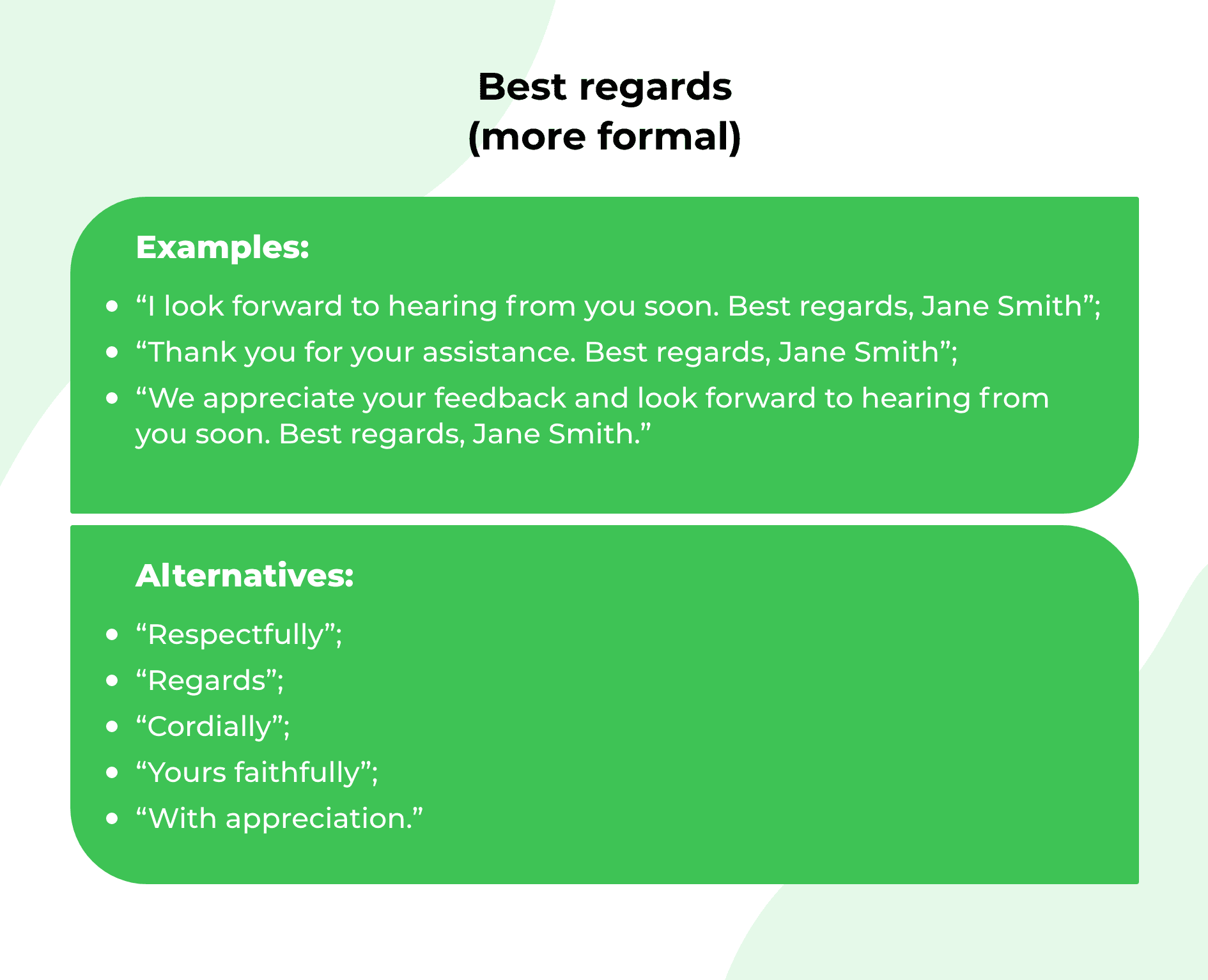
For example, some alternative closings include:
- “Respectfully”;
- “Regards”;
- “Cordially”;
- “Yours faithfully”;
- “With appreciation.”
When to use “Kind regards”
“Kind regards” is a more casual closing than “Best regards,” and it is often used in emails where you want to show respect but maintain an informal atmosphere. For example, it can be used when emailing friends, family, or colleagues with whom you have an existing relationship, as well as in follow-up emails, thank-you notes, or cover letters.
It is also important to note that “Kind regards” shouldn’t be used when writing to someone you don’t know well, as it could come across as too familiar. Using “Best regards” shows respect and creates an appropriate formality in these situations.
You may also use “Kind regards” or its alternative after a phone screening. For example, suppose you were on a job interview where the interviewer was impressed by your qualifications.
In that case, you could use “Kind regards” to show appreciation for the conversation and emphasize a friendly relationship.
Examples of “Kind regards”:
- “I'm looking forward to working with you on this project. Kind regards, Jane Smith;”
- “Thank you for the opportunity. Kind regards, Jane Smith;”
- “It was great meeting you yesterday. Kind regards, Jane Smith.”
While “Kind regards” remain one of the most popular email closings, other alternatives can help you tailor your messages to the purpose they serve better.
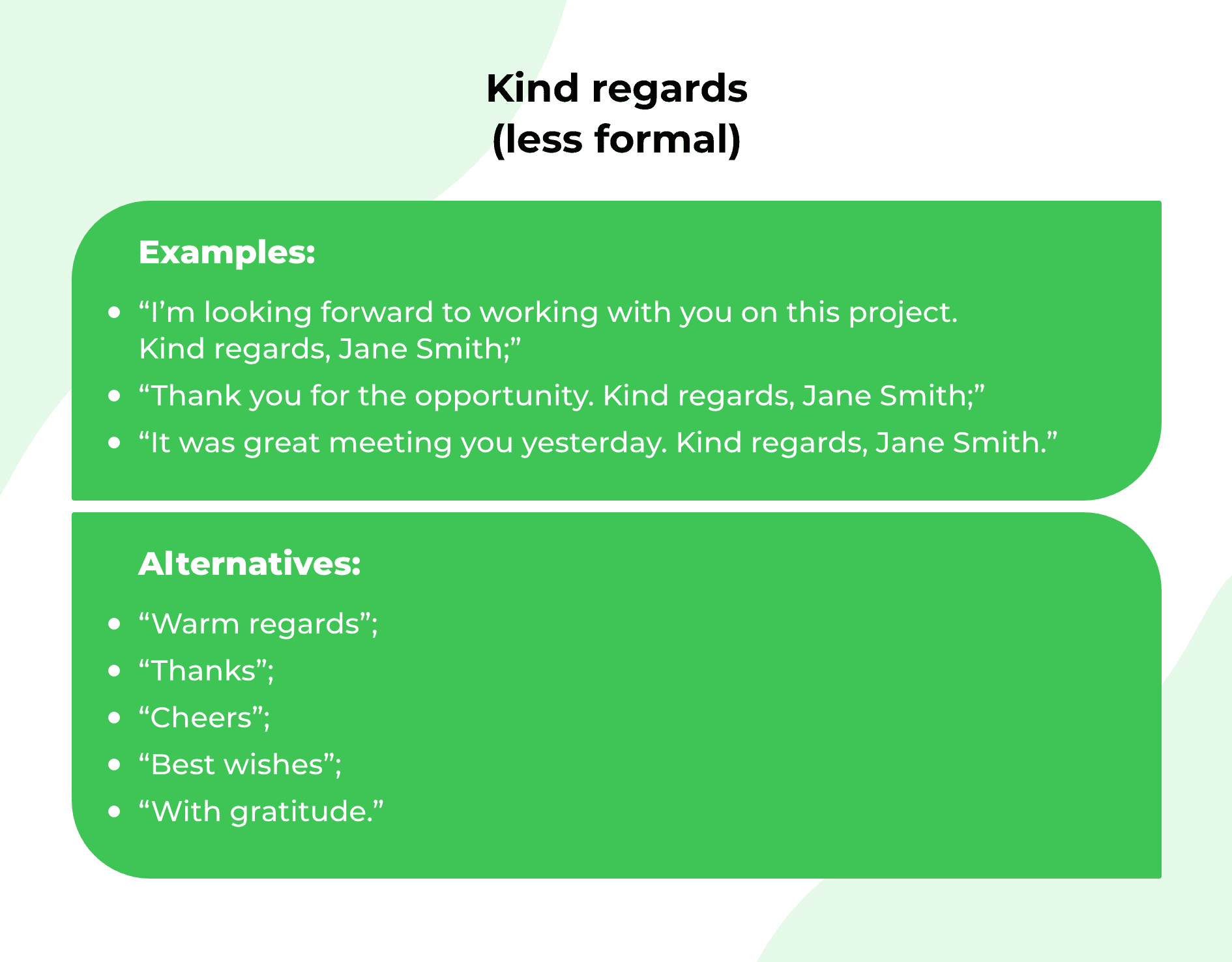
Some examples include:
- “Warm regards”;
- “Thanks”;
- “Cheers”;
- “Best wishes”;
- “With gratitude.”
Wrapping up
An appropriate email ending can make all the difference between success and failure. It shows that you value the recipient's time, appreciate their efforts, and understand their situation. Whether it’s a business email or a job application cover letter, show professionality in how you end emails.
When it comes to choosing the right kind of email ending, it is essential to consider the situation and the recipient's expectations. Generally speaking, using “Best regards” when writing a professional or business-related email is more appropriate.
On the other hand, if you are writing to someone for the first time or addressing those who have helped you somehow, then using “Kind regards” can create a more positive rapport between you and the recipient.
So, choose carefully, as this can make all the difference between success and failure.




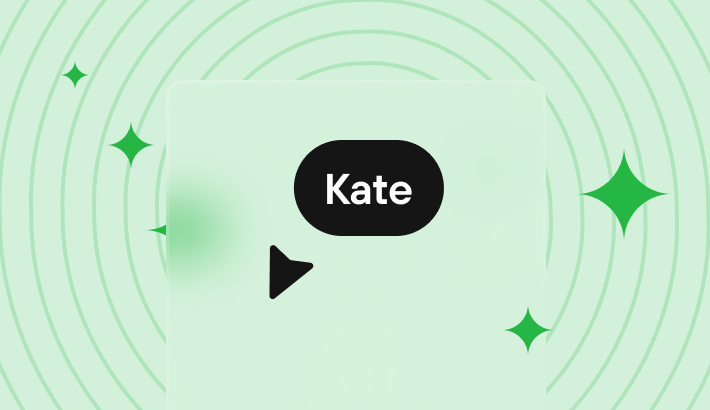

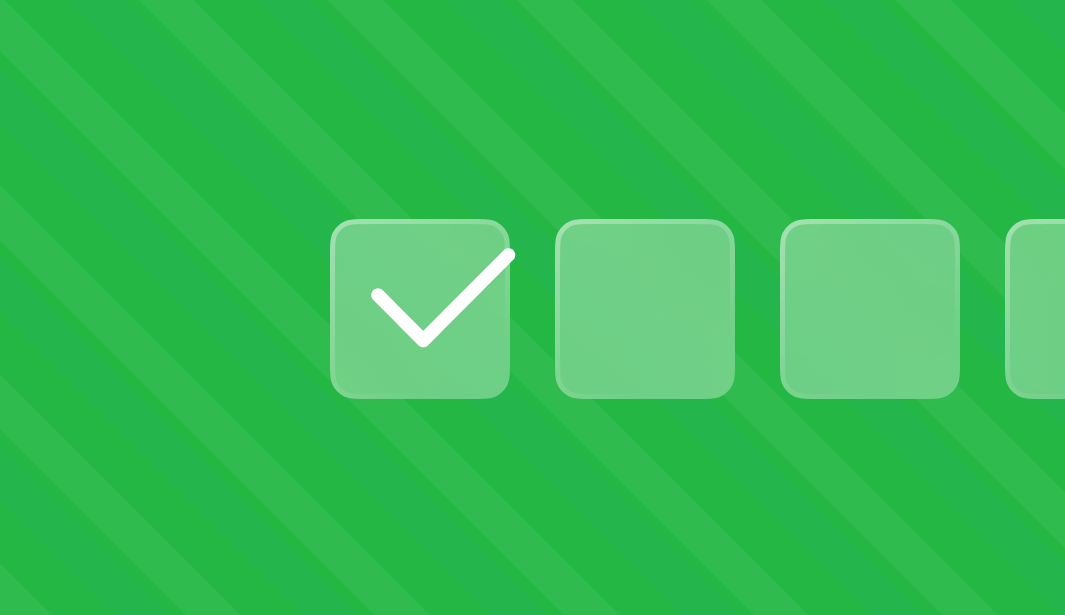

0 comments